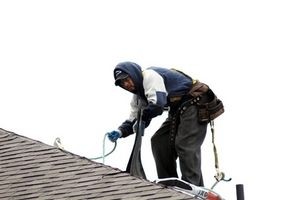Contractor Safety Training

Contractor safety training should be an ongoing exercise in a construction company. At a minimum, it should involve all employees who work or manage in the field, but it can also be expanded to include subcontractors as well. Good safety practices make safer workplaces, and there is no guarantee that all non-employee contractors have undergone the same training as the Occupational Safety and Health Administration (OSHA) or the general contracting company may require.
OSHA Training
The OSHA Construction Safety and Health Course covers worker health and physical risks, personal protective equipment, fire protection and prevention, safety signage, material handling and storage, hand and power tools, arc welding, electrical safety, scaffolding, fall protection, cranes, mechanized equipment, motor vehicles, excavations, concrete construction, steel erection, demolition, blasting, power distribution, overhead protection and ladder safety. When taking the class, OSHA limits the number of students to 30, and it is usually a one day class or seminar. OSHA recommends that the class be taken every three years.
Scaffolding Safety
OSHA requires a scaffold training course for workers who work more than 6 feet off the ground.
A scaffolding and training course should cover the proper use of scaffolding. The course is a mandatory requirement for an OSHA approved job site for workers who work six feet or more off of the ground and on scaffolding. The course, which usually takes four to eight hours to complete, covers guardrail systems, personal fall arrest systems, warning line systems, controlled access zone systems, safety monitor systems, floor opening protective systems, falling object protective systems, fall protection plans, safety net systems, positioning device system and new fall protection technologies.
Fall Protection
The four to eight hour Fall Protection Course is required for workers who work six feet or more above the ground. The Fall Protection Course covers guardrail systems, personal fall arrest systems, warning line systems, controlled access zone systems, safety monitor systems, floor opening protective systems, falling object protective systems, fall protection plans, safety net systems, positioning device systems, and new fall protection technologies.
Excavation Protection
Open excavation work requires an Excavation Protections Systems Course.
OSHA mandates the Excavation Protection Systems Course for any workers who conduct their work around or in excavations of any depth. Topics include the nature of, and protection from, excavation hazards, regulatory requirements for excavations, the nature of and classification of soil types, steps to take before and during excavation, one-call notification and utility marking color codes, emergency actions for cave-ins, sloping protective systems, shoring protective systems and shielding protective systems.
Confined Spaces
OSHA now requires workers who work in confined spaces to take the Confined Spaces Training Course. The four- to eight-hour course teaches the hazards of confined spaces, regulatory requirements for confined spaces, the owner's duties, the authorized entrant's duties, the attendant's duties, the entry supervisor's duties, specialized equipment and emergency procedures.
OSHA Training
The OSHA Construction Safety and Health Course covers worker health and physical risks, personal protective equipment, fire protection and prevention, safety signage, material handling and storage, hand and power tools, arc welding, electrical safety, scaffolding, fall protection, cranes, mechanized equipment, motor vehicles, excavations, concrete construction, steel erection, demolition, blasting, power distribution, overhead protection and ladder safety. When taking the class, OSHA limits the number of students to 30, and it is usually a one day class or seminar. OSHA recommends that the class be taken every three years.
Scaffolding Safety
OSHA requires a scaffold training course for workers who work more than 6 feet off the ground.
A scaffolding and training course should cover the proper use of scaffolding. The course is a mandatory requirement for an OSHA approved job site for workers who work six feet or more off of the ground and on scaffolding. The course, which usually takes four to eight hours to complete, covers guardrail systems, personal fall arrest systems, warning line systems, controlled access zone systems, safety monitor systems, floor opening protective systems, falling object protective systems, fall protection plans, safety net systems, positioning device system and new fall protection technologies.
Fall Protection
The four to eight hour Fall Protection Course is required for workers who work six feet or more above the ground. The Fall Protection Course covers guardrail systems, personal fall arrest systems, warning line systems, controlled access zone systems, safety monitor systems, floor opening protective systems, falling object protective systems, fall protection plans, safety net systems, positioning device systems, and new fall protection technologies.
Excavation Protection
Open excavation work requires an Excavation Protections Systems Course.
OSHA mandates the Excavation Protection Systems Course for any workers who conduct their work around or in excavations of any depth. Topics include the nature of, and protection from, excavation hazards, regulatory requirements for excavations, the nature of and classification of soil types, steps to take before and during excavation, one-call notification and utility marking color codes, emergency actions for cave-ins, sloping protective systems, shoring protective systems and shielding protective systems.
Confined Spaces
OSHA now requires workers who work in confined spaces to take the Confined Spaces Training Course. The four- to eight-hour course teaches the hazards of confined spaces, regulatory requirements for confined spaces, the owner's duties, the authorized entrant's duties, the attendant's duties, the entry supervisor's duties, specialized equipment and emergency procedures.
- d8ed449a56837767320327778778804c4b.jpg